25 November, 2001
Last night, Dr. Bowser and I took the Ski-Doo to the Herbertson Glacier to
relieve Dr. Pawlowski and Dr. Alexander from their 12- hour shift at the
melthole. It will take two days to melt a dive hole, so Dr. Bowser
scheduled two person teams to monitor the drill/melt process. The weather
was beautiful as we left field camp for the 90 minute drive to the remote
camp. The sea ice was rough as we rode through sections of sastrugi (waves
of ice). The scenery was spectacular as we drove past Mt. Erebus, glaciers,
and massive icebergs. The wind had picked up by the time we arrived at the
camp. Dr. Pawlowski showed me how to light the Coleman stove, while Dr.
Alexander and Dr. Bowser worked on the stubborn generator.
Phil Forte and Dr. Korsun had set up a tent the day before, so it was a
nice escape from the wind. The tent was nestled among beautiful ice
formations. The view was incredible as I looked around at the surrounding
mountains, glaciers, beach area, ice formations, and sea ice. I could see
the Herbertson Glacier and the Ferrar Glacier from the melthole site. This
all-day operation involved drilling through the ice with 12-foot long drill
sections. A generator and melter were fueled by gasoline and diesel fuel.
Dr. Bowser taught me how to carefully transfer the fuel from the barrels
into the equipment. Drop cloths were used to protect the surface of the ice
from any spillage. Antarctica's pristine environment is protected by strict
regulations that must be followed.
While the hole was melting, there was time for a little exploration, so we
visited the Herbertson Glacier. It seemed to be just a short distance away,
but it took about an hour to walk there. The ice crystals and structures on
this glacier were beautiful. It looked like a frozen waterfall cascading
over the sides of a mountain. I could hear running water near the frozen
blue stream. I couldn't see the melted water, but I loved the sound. The
ice seemed to sparkle as the sun hit it.
When Dr. Korsun and Phil Forte had arrived back at camp around 2 p.m.,
holes were drilled in a circular pattern to help open up the dive hole.
After much drilling and ice chiseling, the hole was ready to be scooped
free of ice. The dive hole was groomed, and a snow wall was built to
protect the divers from the wind. Phil, Dr. Bowser, and Dr. Alexander will
return tomorrow to dive and collect specimens at this site. It will be an
interesting comparison with Explorers Cove.
When we left the remote camp, Dr. Korsun drove one of the Ski-Doos, which
pulled empty gasoline barrels, bags, and me. Dr. Bowser gave me a pole in
case I needed to notify him if I encountered any trouble on the way back.
Dr. Bowser sat on a crate behind Dr. Korsun. Phil Forte drove the smaller
Ski-Doo, which pulled a banana sled filled with supplies. As we were
"mushing" along on the Ski-Doos, we passed a huge Weddell seal sprawled
across the ice. I really wanted a picture, but restrictions in Antarctica
protect seals and penguins from interaction with people. I feel fortunate
that I had the opportunity to capture this image in my mind. It was about 1
a.m. when we arrived back at our camp at Explorers Cove, and was surprised
to find a delicious curry made by Dr. Alexander. It was after 2 a.m. before
anyone got to bed.

It is a beautiful day today! We took time to get a closer look at the Herbertson Glacier.
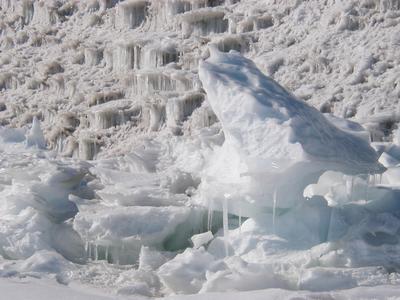
The ice formations in Antarctica have been spectacular.

The melter slowly melts through the ice. This "drill/melt" process will take two days.

Drilling through the ice near the Herbertson Glacier to form a dive hole to collect sediment with forams.
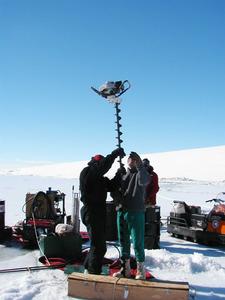
Drilling through 12-feet of ice at the melt hole
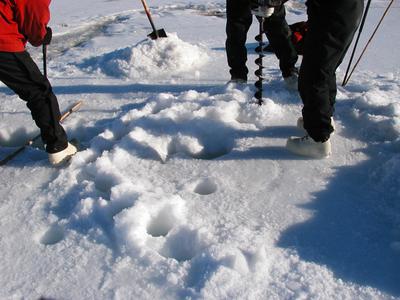
Making dive hole near the Herbertson Glacier
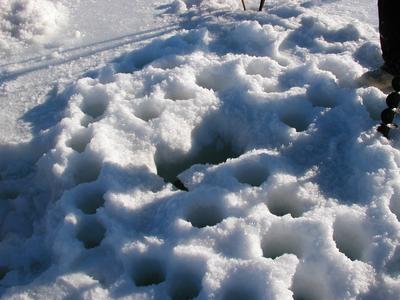
Drilling several holes in a circular pattern helps speed up the process in making a dive hole.
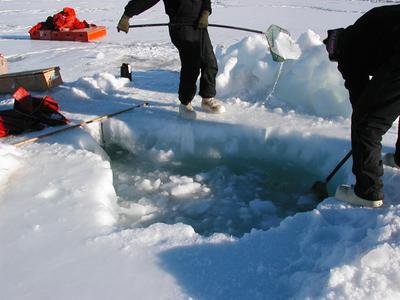
Scooping ice out of dive hole must be done in order to clear hole for the upcoming dive tomorrow.

I am scooping ice to clear the dive hole.
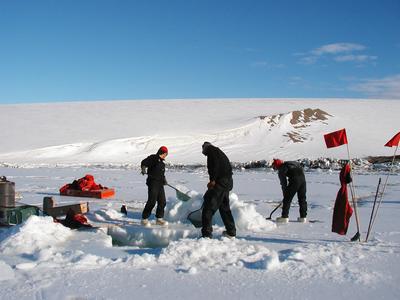
Grooming the dive hole is important for safety issues. The divers have heavy gear, and they need to be protected from falling on the ice or into the hole before they are ready to dive. The extra ice cleared from the hole was used to build a snow wall to protect the divers from the wind.

The dive hole near the Herbertson Glacier
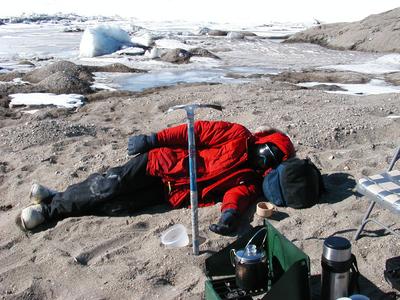
Phil Forte taking a short nap after his exhausting two days of intensive drilling, melting, and grooming the dive hole. He will come back tomorrow to make two dives before doing a substantial amount of work to break up camp and reload all of the equipment and gear.
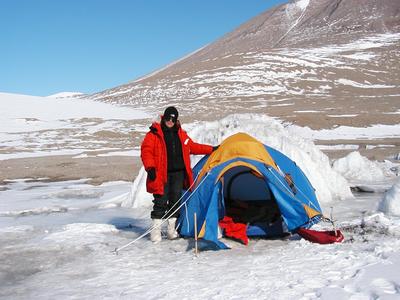
I am at our tent site, which is surrounded by beauty on all sides.
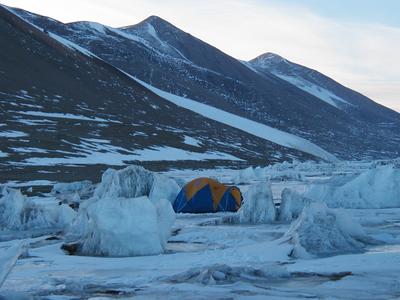
I can't help but marvel at the beautiful ice forms around our remote camp site.
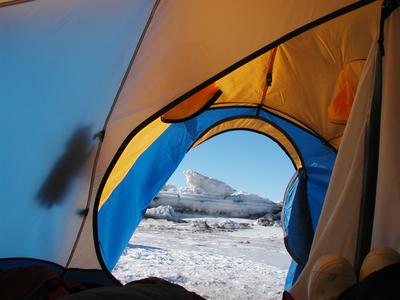
A view from the tent

The transition zone near the Herbertson Glacier
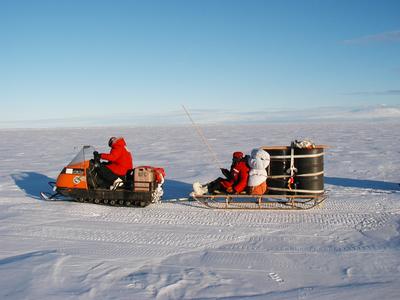
This was my transportation back to our field camp. I was pulled on the sled behind the Ski-doo as we made the 90 minute trip back over the rough sea ice. We skimmed past Mt. Erebus, massive icebergs, and a huge Weddell seal on the ice. The pole was used to notify Dr. Korsun and Dr. Bowser on the Ski-doo if any trouble occurred during the ride back to camp. I only had to use it once. I noticed that Phil Forte had stopped to make some adjustments on his Ski-doo and gear, and I wanted the others to notice that he had stopped. As an extra precaution, both ski-doos had hand held radios. We also made contact with our field camp to let them know that we were on our way back.
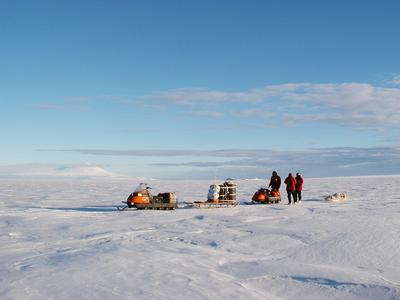
Transportation on the sea ice on our return trip from the Herbertson Glacier area
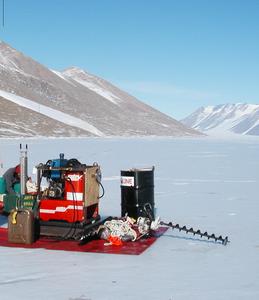
Melting a Dive Hole: This photo is out of order because a friend who wanted to know more about the drill/melt process requested additional information. In this photo, note that everything is carefully placed on a red drop cloth to protect any fuel spillage on the ice. The jiffy drill, which looks like a boat motor attached to a huge drill, is started much like a lawn mower with a pull-cord handle. The jiffy drill makes the initial hole through the sea ice. Additional drill attachments are added until the jiffy drill breaks through the sea ice. (Note one of the jiffy drill photos above as it towers over Dr. Bowser and Dr. Korsun.) Water and slush will gush up through the opening. The sea ice is 12 feet deep this year. A single loop "trombone" melter is used to open up the hole. This piece of equipment will melt the jiffy hole to a wider diameter, so that it can accept the big coil. This process takes about two hours. The big coil (the silver coiled device standing upright in front of Dr. Bowser in this photo) will take as much as 36 hours to melt a bigger opening in the ice. The red generator and heater in the box are located in the center of the photo. The generator, which uses MoGas (Motor Automated Gasoline), provides electricity for the pump, which circulates hot glycol (antifreeze). The heater, which uses diesel fuel to heat the circulated glycol, provides the heat necessary to heat the glycol. This results in a small hole at the surface with a big cavern melted out underneath the ice. The jiffy drill, with a single flight, will be used to make holes in a circular pattern. This will punch holes in the ice in order to get rid of the top layer of ice. A breaker bar will be used to break up ice on the surface; then ice will be scooped out of the dive hole. The dive hole will be groomed for safety and easy accessibility to the dive hole. The excess ice will be used to build a wind block to shelter the divers. This drill/melt process started late Friday afternoon. It took two days to melt a hole and prepare it for a dive for the following Monday. This process takes time because everything had to be transported to and from the site with extra precautions taken to prevent any fuel spillage on the ice. Dr. Bowser taught me how to start the generator, which died several times during this process. He also taught me how to properly fuel the generator and heater.
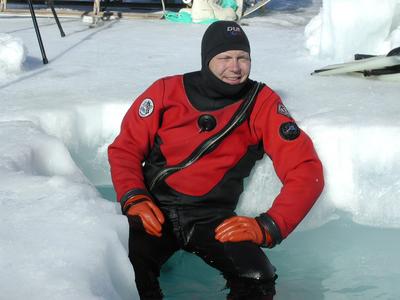
Dr. Bowser is getting ready to dive at the newly prepared dive hole.
Contact the TEA in the field at
.
If you cannot connect through your browser, copy the
TEA's e-mail address in the "To:" line of
your favorite e-mail package.
|
